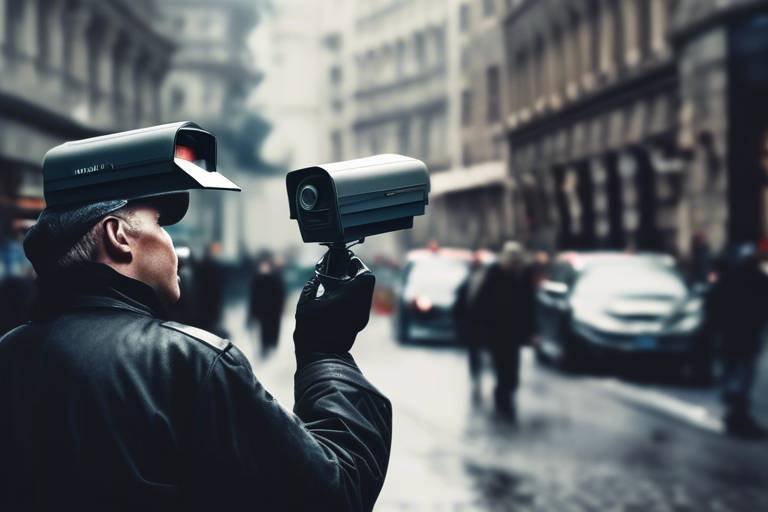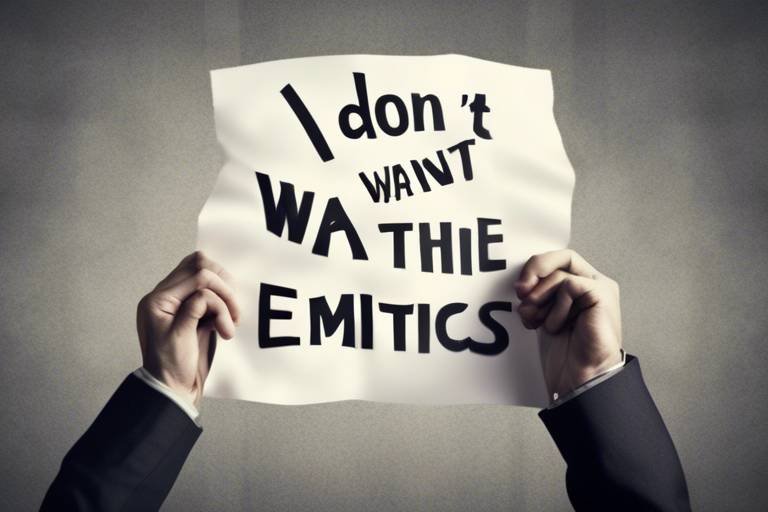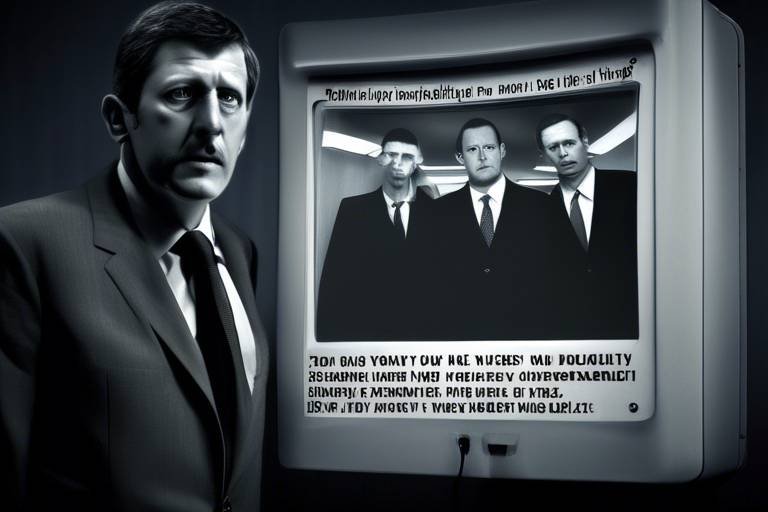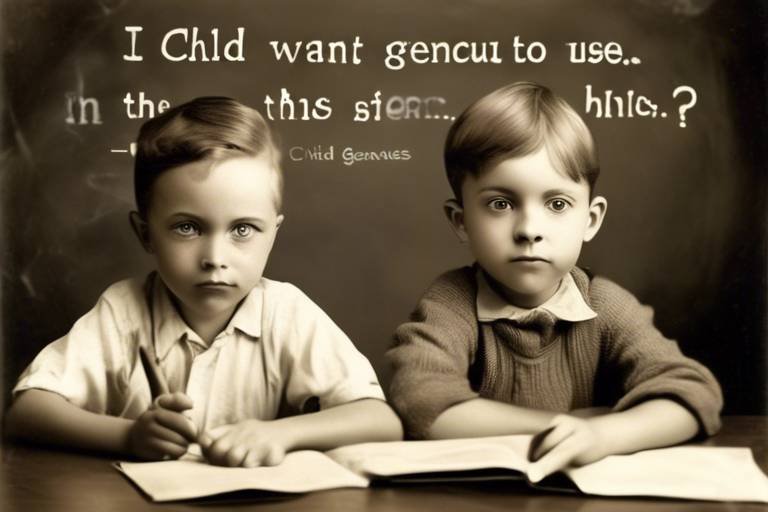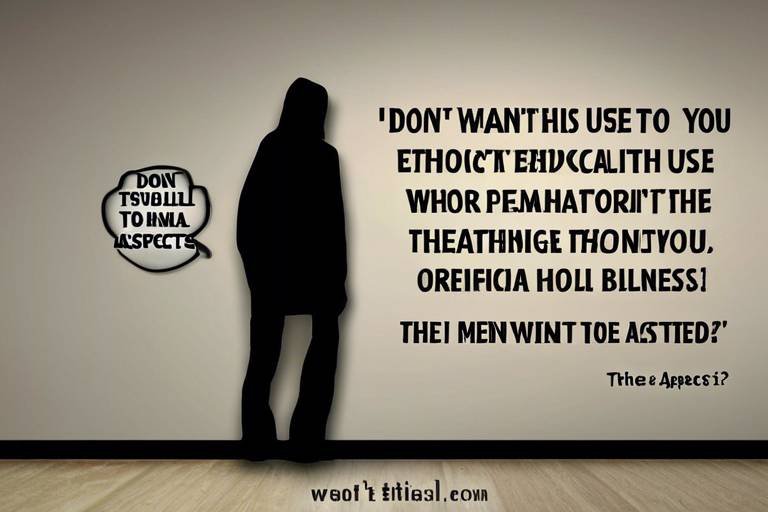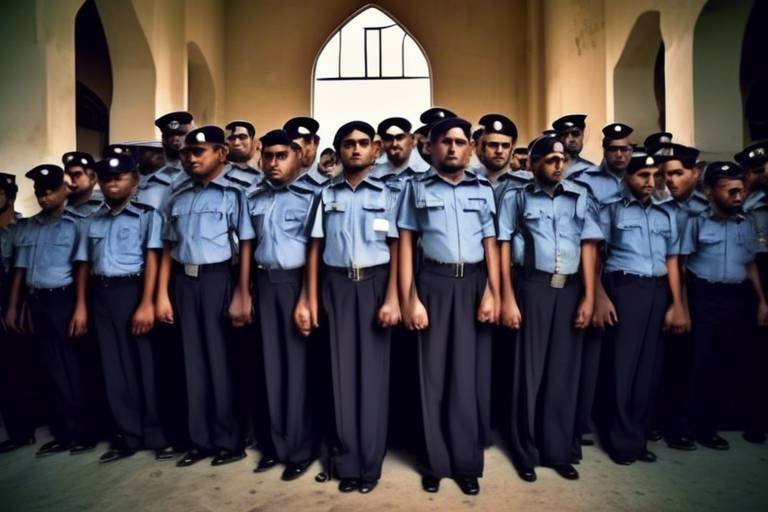Understanding the Ethics of Non-violent Protest
In an era where the world seems divided on many fronts, the idea of non-violent protest resonates more than ever. It’s not just about raising voices; it’s about raising consciousness. The ethics behind non-violent protest are deeply rooted in the belief that change can be achieved without resorting to violence. This notion is not merely theoretical; it’s a call to action that has been championed by influential figures throughout history. Imagine a world where justice is pursued through dialogue rather than destruction. Isn't that a powerful vision?
At its core, non-violent protest embodies a moral stance that challenges the status quo while promoting respect for human dignity. Think about it: when individuals engage in peaceful resistance, they are not only advocating for their own rights but also for the rights of others. This interconnectedness is the ethical backbone of non-violent movements. It’s about standing up for what’s right, even when the odds are stacked against you. In this article, we will delve into the principles, significance, and challenges of non-violent protest, exploring its ethical dimensions and its profound impact on society.
One of the most compelling aspects of non-violent protest is its ability to draw attention to injustices without perpetuating a cycle of violence. It calls upon individuals to engage in acts of civil disobedience, where they intentionally violate laws they perceive as unjust. This act is not merely a rebellious gesture; it is a profound ethical statement that highlights the need for societal change. By refusing to comply with unjust laws, protesters illuminate the moral failings of those in power. They challenge the very fabric of societal norms, urging others to rethink their beliefs and actions.
As we navigate through the complexities of non-violent protest, it is essential to recognize the various challenges faced by activists. From government repression to public misunderstanding, the road to justice is fraught with obstacles. Yet, despite these challenges, the ethical commitment to non-violence remains steadfast. It’s akin to planting seeds in a drought; the growth may be slow, but with persistence and care, a lush garden of change can emerge.
In the upcoming sections, we will explore the philosophical foundations of non-violent protest, the historical context of civil disobedience, and the impact these movements have had on society. We will also address the media's role in shaping public perception and the global perspectives on non-violent activism. Through this exploration, we aim to uncover the ethical dimensions that make non-violent protest not just a method of resistance, but a profound moral imperative.
- What is non-violent protest? Non-violent protest is a form of activism that seeks to bring about social change through peaceful means rather than violence.
- Who are some key figures associated with non-violent protest? Influential figures include Mahatma Gandhi, Martin Luther King Jr., and Nelson Mandela, all of whom advocated for justice through non-violent means.
- What are the ethical implications of civil disobedience? Civil disobedience raises questions about the morality of breaking laws deemed unjust, highlighting the conflict between legal obligations and ethical principles.
- How does media representation affect non-violent protests? Media coverage can significantly influence public support for non-violent protests, shaping perceptions and narratives around the movements.

The Philosophy Behind Non-violent Protest
When we dive into the philosophy of non-violent protest, we uncover a rich tapestry of moral reasoning that advocates for peaceful resistance as a powerful tool for social change. Think about it: throughout history, the most transformative movements have often embraced non-violence, and this approach is deeply rooted in the teachings of influential thinkers like Mahatma Gandhi and Martin Luther King Jr.. These leaders didn't just stumble upon the idea of peaceful protest; they meticulously crafted their philosophies around the belief that love and understanding could triumph over hatred and oppression.
Gandhi famously stated, "Non-violence is the greatest force at the disposal of mankind." This perspective emphasizes that non-violent protest is not merely a passive resistance but a dynamic force that can shake the very foundations of injustice. By choosing to engage in peaceful methods, protesters challenge the status quo while respecting the humanity of their adversaries. This ethical stance raises an important question: if we can achieve our goals without inflicting harm, why would we choose violence?
Moreover, the philosophical underpinnings of non-violent protest can be segmented into several key principles:
- Respect for All Life: At its core, non-violence is about recognizing the intrinsic value of every individual, even those who oppose us. This principle encourages dialogue over destruction.
- Power of Love: Gandhi and King both believed in the transformative power of love as a means to overcome hate. They argued that love could disarm even the most hardened hearts.
- Ethical Responsibility: Engaging in non-violent protest is seen as a moral duty to stand against injustice, pushing individuals to act in accordance with their ethical beliefs.
- Community and Solidarity: Non-violent movements often emphasize collective action, fostering a sense of unity that empowers individuals to stand together against oppression.
These principles not only serve as a foundation for non-violent activism but also challenge us to reflect on our own values and actions. Are we willing to confront injustice without resorting to violence? This is a profound ethical dilemma that many activists face, and it often requires immense courage and conviction.
Furthermore, the philosophical discourse surrounding non-violent protest is not limited to historical figures. Contemporary thinkers and activists continue to explore and expand upon these ideas, adapting them to modern contexts. In a world where social media amplifies voices and movements, the philosophy of non-violence remains relevant, urging us to consider the impact of our actions in the digital age.
In essence, understanding the philosophy behind non-violent protest invites us to engage in a deeper conversation about justice, ethics, and the human experience. It challenges us to ask ourselves: how can we contribute to a world that prioritizes peace and understanding over conflict and division? This is not just a question for activists; it’s a question for all of us.
- What is non-violent protest? Non-violent protest is a form of activism that seeks to bring about social change through peaceful means, avoiding violence and aggression.
- Who are some key figures associated with non-violent protest? Influential figures include Mahatma Gandhi, Martin Luther King Jr., and more recently, activists like Malala Yousafzai.
- Why is non-violence considered effective? Non-violence can garner broader public support, disarm opponents, and create a moral high ground, making it a powerful tool for social change.
- What are some challenges faced by non-violent protesters? Challenges can include government repression, public misunderstanding, and the temptation to resort to violence in the face of aggression.

The Role of Civil Disobedience
Civil disobedience is often regarded as the heartbeat of non-violent protest movements. It embodies the idea that individuals have a moral obligation to resist laws and regulations that they perceive as unjust. This form of protest is not merely about breaking the law; it is a powerful statement of conscience and a call to action that seeks to challenge the status quo. Think of it as a ripple effect in a pond—each act of defiance sends waves of awareness and change that can ultimately transform societal norms.
At its core, civil disobedience operates on the principle that laws are not inherently just and that individuals can take a stand against systemic injustices. This ethical stance has been championed by legendary figures such as Henry David Thoreau, who famously declared that “government is best which governs least.” His essay, "Civil Disobedience," laid the groundwork for future activists, emphasizing that individuals must prioritize their moral compass over blind obedience to the law.
Throughout history, civil disobedience has been instrumental in igniting social change. For instance, during the American Civil Rights Movement, leaders like Martin Luther King Jr. employed civil disobedience as a strategy to combat racial segregation. By intentionally breaking unjust laws—such as those enforcing segregation in public spaces—activists highlighted the moral failings of such legislation. Their actions were not without risk; they faced arrest, violence, and societal backlash. However, the ethical implications of their struggle resonated deeply with the public, garnering widespread support for their cause.
In examining the ethical implications of civil disobedience, it is essential to consider the following key aspects:
- Moral Responsibility: Activists believe that they have a duty to oppose unjust laws, which can be viewed as a higher moral calling.
- Non-violence: Civil disobedience is rooted in non-violence, which distinguishes it from more aggressive forms of protest. This commitment to peaceful resistance is crucial in maintaining moral high ground.
- Awareness Raising: By breaking the law, activists draw attention to the issues at hand, encouraging public discourse and awareness.
Historically, civil disobedience has been a catalyst for change in various contexts. From the Salt March led by Mahatma Gandhi in 1930, which protested British salt laws in India, to the recent protests against climate change, the act of civil disobedience has shown that individuals can challenge oppressive systems and inspire collective action. Each of these movements illustrates how civil disobedience can effectively mobilize communities and shift public opinion.
However, it's important to recognize that civil disobedience comes with its own set of challenges. Activists often face legal repercussions, societal ostracism, and even violence. These challenges raise ethical questions: Is it justifiable to break the law for a greater cause? How do activists navigate the fine line between moral conviction and legal accountability? These dilemmas are at the heart of the ongoing discourse surrounding civil disobedience, making it a complex yet fascinating subject of study.
In conclusion, civil disobedience plays a pivotal role in non-violent protest by allowing individuals to voice their dissent against injustice. It serves as a moral compass for activists, guiding their actions and inspiring others to join the fight for a more just society. The ethical dimensions of civil disobedience not only challenge existing laws but also compel society to reflect on its values and priorities, ultimately paving the way for meaningful change.
1. What is civil disobedience?
Civil disobedience is the act of intentionally disobeying certain laws or commands of a government in a peaceful manner to highlight injustice and promote social change.
2. Who are some notable figures associated with civil disobedience?
Prominent figures include Mahatma Gandhi, Martin Luther King Jr., and Henry David Thoreau, all of whom have made significant contributions to the philosophy and practice of civil disobedience.
3. What are the ethical implications of civil disobedience?
The ethical implications revolve around the moral responsibility to oppose unjust laws, the commitment to non-violence, and the potential consequences activists may face.
4. How has civil disobedience influenced social movements?
Civil disobedience has been crucial in various social movements by raising awareness, mobilizing communities, and challenging oppressive systems, leading to significant societal changes.

Historical Context of Civil Disobedience
The roots of civil disobedience can be traced back through history, revealing a tapestry of courageous individuals and movements that have challenged unjust laws and oppressive regimes. This concept, deeply intertwined with the fabric of social justice, has manifested in various forms across different cultures and eras. At its core, civil disobedience is not merely a tactic; it is a moral stance that asserts the individual's responsibility to oppose laws that are fundamentally wrong or harmful to society.
One of the earliest recorded instances of civil disobedience dates back to ancient Greece, where philosophers like Socrates advocated for questioning the status quo. Socrates famously accepted his death sentence rather than escape from prison, illustrating the profound commitment to his principles. Fast forward to the 19th century, and we see Henry David Thoreau, who, in his essay "Civil Disobedience," articulated the need to resist government actions that violate individual conscience. Thoreau's refusal to pay taxes as a protest against slavery and the Mexican-American War laid the groundwork for future activists.
In the 20th century, civil disobedience gained significant traction as a powerful tool for social change, particularly in the United States. The civil rights movement, spearheaded by figures like Martin Luther King Jr., employed non-violent resistance to combat racial segregation and discrimination. King’s philosophy was heavily influenced by Mahatma Gandhi, who successfully led India’s struggle for independence through non-violent means. Both leaders understood that civil disobedience could galvanize public opinion and challenge systemic injustices, leading to meaningful reforms.
| Key Events in Civil Disobedience | Date | Location | Outcome |
|---|---|---|---|
| Sit-ins at segregated lunch counters | 1960 | United States | Increased awareness and led to the desegregation of public facilities |
| Salt March | 1930 | India | Mobilized mass support for Indian independence |
| Women’s Suffrage Movement | Early 20th Century | United States | Resulted in the 19th Amendment, granting women the right to vote |
These historical examples illustrate how civil disobedience has served as a catalyst for change, often at great personal risk to the individuals involved. The ethical implications of such actions are profound; they challenge not only the laws themselves but also the moral fabric of society. Civil disobedience asks us to reflect on the nature of justice and the responsibilities of citizenship. When laws perpetuate injustice, the act of disobeying them becomes a powerful statement of ethics and humanity.
However, the path of civil disobedience is fraught with challenges. Activists often face severe repercussions, including arrest, violence, and societal ostracism. Yet, the history of civil disobedience teaches us that these sacrifices can lead to monumental shifts in public consciousness and policy. The ethical dilemmas faced by these individuals—balancing personal safety against the need for social justice—highlight the complex interplay between legality and morality.
As we reflect on the historical context of civil disobedience, it becomes clear that its legacy is not just about the actions taken but about the ideals they represent. Each act of defiance against injustice adds a thread to the ongoing narrative of human rights and dignity, inspiring future generations to stand up for what is right, even when the odds seem insurmountable.
- What is civil disobedience?
Civil disobedience is the act of intentionally disobeying laws that are considered unjust, often through non-violent means. - Who are some key figures in civil disobedience?
Influential figures include Mahatma Gandhi, Martin Luther King Jr., and Henry David Thoreau. - What are the ethical implications of civil disobedience?
Civil disobedience raises questions about the morality of laws, individual conscience, and the responsibilities of citizens to challenge injustice. - Can civil disobedience lead to social change?
Yes, history shows that civil disobedience can effectively mobilize public opinion and lead to significant social and political reforms.

Key Figures in Civil Disobedience
The landscape of civil disobedience is rich with influential figures whose philosophies and actions have profoundly shaped the practice of non-violent protest. One cannot discuss this topic without mentioning Mahatma Gandhi, whose approach to non-violence was rooted in the belief that moral power could triumph over physical force. Gandhi's concept of Satyagraha, or "truth force," emphasized the importance of steadfastness in the pursuit of justice. His leadership during the Indian independence movement not only inspired millions but also provided a blueprint for future civil rights movements around the world.
Another pivotal figure is Martin Luther King Jr., whose eloquent advocacy for civil rights in the United States was deeply influenced by Gandhi's principles. King famously stated, "Injustice anywhere is a threat to justice everywhere," highlighting the interconnectedness of struggles for justice. His ability to mobilize communities through peaceful protests, such as the Montgomery Bus Boycott and the March on Washington, showcased the effectiveness of civil disobedience in challenging systemic racism and inequality.
Additionally, figures like Rosa Parks and Henry David Thoreau deserve recognition. Parks' refusal to give up her bus seat became a defining moment in the civil rights movement, symbolizing the power of individual acts of defiance against unjust laws. Thoreau, on the other hand, laid the philosophical groundwork for civil disobedience with his essay "On the Duty of Civil Disobedience," where he argued that individuals should not permit governments to overrule their consciences. His thoughts resonate even today, as they encourage people to question authority and stand up against injustice.
The impact of these figures extends beyond their immediate contexts; their legacies continue to inspire activists globally. For instance, the Arab Spring and various movements advocating for climate justice have drawn on the teachings and strategies of these historical leaders. Their lives remind us that the path of non-violent protest is not without its challenges, but it is a path that can lead to profound social change. In essence, these key figures in civil disobedience illustrate that the fight for justice is not just a historical narrative but an ongoing dialogue that requires courage, commitment, and ethical consideration.
In summary, understanding the contributions of these key figures helps us appreciate the ethical dimensions of civil disobedience. Their philosophies and actions serve as guiding lights for current and future activists, emphasizing that the quest for justice is a collective endeavor that transcends time and geography.
- What is civil disobedience?
Civil disobedience is the intentional act of breaking laws or regulations that are deemed unjust, often as a form of protest against social or political issues.
- Who were the most influential figures in civil disobedience?
Some of the most notable figures include Mahatma Gandhi, Martin Luther King Jr., Rosa Parks, and Henry David Thoreau.
- How does non-violent protest impact society?
Non-violent protest can lead to significant social change by raising awareness, influencing public opinion, and prompting legislative reforms.
- Can civil disobedience be justified?
Many argue that civil disobedience is justified when laws are unjust and when peaceful means of change have been exhausted.

Case Studies of Successful Movements
When we think about non-violent protest, several remarkable movements come to mind that have not only shaped history but also provided a blueprint for peaceful resistance. These movements serve as powerful case studies, demonstrating how ethical principles can guide actions and lead to significant social change. One of the most notable examples is the Indian Independence Movement, led by Mahatma Gandhi. Gandhi's philosophy of Satyagraha, which translates to "truth force," emphasized the power of non-violent resistance against British colonial rule. His approach inspired millions to join the struggle, culminating in India's independence in 1947.
Another pivotal movement was the Civil Rights Movement in the United States during the 1950s and 1960s. Figures like Martin Luther King Jr. utilized non-violent protests, such as the Montgomery Bus Boycott and the March on Washington, to demand equal rights for African Americans. King's famous "I Have a Dream" speech not only galvanized support but also highlighted the ethical necessity of justice and equality. The success of this movement led to significant legislative changes, including the Civil Rights Act of 1964 and the Voting Rights Act of 1965, which aimed to dismantle systemic racism.
Moreover, the Anti-Apartheid Movement in South Africa is another exemplary case of effective non-violent protest. Led by figures like Nelson Mandela and organizations such as the African National Congress (ANC), this movement utilized strategies like boycotts, strikes, and peaceful demonstrations to challenge the oppressive apartheid regime. The global solidarity and ethical stance against apartheid eventually led to its dismantling in the early 1990s. These case studies illustrate not only the power of non-violent protest but also the ethical frameworks that underpin these movements, showcasing how collective action can lead to transformative social change.
In addition to these historical examples, we can also look at more recent movements such as the Arab Spring, which began in 2010. Citizens across the Middle East and North Africa engaged in mass protests, demanding democratic reforms and an end to oppressive regimes. While not all instances of the Arab Spring adhered strictly to non-violent principles, many movements, such as those in Tunisia, showcased the potential for peaceful protest to initiate political change. The outcomes of these movements highlight the complexities and challenges faced by non-violent activists in contemporary contexts.
To summarize, the case studies of successful non-violent movements reveal a rich tapestry of strategies and ethical considerations. From Gandhi's Satyagraha to King's dream of equality, these movements are testaments to the enduring power of non-violence in the face of injustice. They remind us that while the path of peaceful protest can be fraught with challenges, the potential for meaningful change is always within reach when guided by strong ethical foundations.

Challenges Faced by Non-violent Protesters
The journey of non-violent protesters is often fraught with challenges that test their resolve and commitment to peaceful resistance. While the ideals of non-violence are noble, the reality on the ground can be quite harsh. Many individuals who choose this path face significant obstacles, including government repression, societal pushback, and the ever-present risk of being misunderstood or misrepresented. Imagine standing up for what you believe in, only to be met with hostility or indifference from those around you. It can be disheartening, but it is crucial to recognize and address these challenges head-on.
One of the most pressing challenges is government repression. In many cases, authorities may view non-violent protests as a threat to the status quo, leading to crackdowns that can include arrests, violence, and the imposition of restrictive laws. This raises a critical ethical dilemma: how do protesters maintain their commitment to non-violence when faced with aggression? History shows us that some movements have successfully navigated this treacherous terrain, but it often requires immense courage and strategic planning.
Another significant hurdle is the public misunderstanding of non-violent protest. Many people may perceive these actions as ineffective or naive, leading to a lack of support or even outright condemnation. This misunderstanding can stem from a variety of factors, including media portrayal and cultural attitudes towards activism. For instance, when media outlets focus more on the disruptions caused by protests rather than the underlying issues, it can skew public perception and diminish the movement's impact. Thus, non-violent protesters must not only advocate for their cause but also work tirelessly to educate the public about their goals and methods.
Moreover, the psychological toll on activists should not be underestimated. The emotional strain of facing hostility, coupled with the pressure to remain peaceful, can lead to feelings of isolation and despair. Many activists find themselves grappling with the question: Is non-violence truly the most effective approach? This internal conflict can create a rift within movements, as some members may begin to question the efficacy of their methods.
Despite these challenges, it is essential to remember that non-violent protest has historically led to significant social change. The key lies in resilience and adaptability. Non-violent protesters often employ various strategies to overcome obstacles, such as:
- Building coalitions with like-minded groups to amplify their message.
- Utilizing social media to spread awareness and garner support.
- Engaging in dialogue with opponents to foster understanding and reduce tensions.
Ultimately, the challenges faced by non-violent protesters are not insurmountable. With determination, creativity, and a strong ethical foundation, they can continue to advocate for justice and inspire others to join their cause. The road may be rocky, but the potential for meaningful change is what makes the struggle worthwhile.
Q: What are the main challenges faced by non-violent protesters?
A: Non-violent protesters often face government repression, public misunderstanding, and the psychological toll of their activism. These challenges can test their commitment to peaceful resistance.
Q: How can non-violent protesters overcome these challenges?
A: By building coalitions, utilizing social media for awareness, and engaging in constructive dialogue, activists can navigate obstacles and strengthen their movements.
Q: Is non-violent protest effective in bringing about change?
A: Yes, history shows that non-violent protests have successfully led to significant social changes, despite the challenges faced by activists.

The Impact of Non-violent Protest on Society
Non-violent protest has a profound and transformative impact on society, acting as a catalyst for change and social justice. When people gather to express their dissent peacefully, they not only challenge the status quo but also inspire others to join their cause. The ripple effects of these actions can lead to significant shifts in public opinion, policy reforms, and even cultural transformations. For instance, the Civil Rights Movement in the United States, characterized by peaceful marches and sit-ins, not only brought about legislative changes but also altered the collective consciousness regarding race and equality.
One of the most striking aspects of non-violent protest is its ability to mobilize large segments of the population. When individuals witness acts of peaceful resistance, it often stirs feelings of solidarity and empathy. These protests can galvanize communities, encouraging people from diverse backgrounds to unite for a common purpose. Such collective action can lead to enhanced visibility for social issues that may have otherwise remained in the shadows. A great example of this is the global response to climate change, where millions have taken to the streets in peaceful demonstrations, demanding action from governments and corporations alike.
Moreover, non-violent protests can influence policy changes at various levels of government. When protesters advocate for change through peaceful means, they often attract media attention, which can amplify their message. This media coverage plays a crucial role in shaping public discourse and can lead to increased pressure on policymakers to address the demands being made. For instance, the #MeToo movement, which began as a grassroots campaign against sexual harassment and assault, has led to significant legislative changes aimed at protecting individuals from such misconduct.
However, the impact of non-violent protest is not solely confined to immediate outcomes. It also has long-term implications for societal values and norms. Non-violent movements often challenge deeply entrenched beliefs and practices, prompting society to reevaluate its ethical frameworks. For example, the anti-apartheid movement in South Africa, led by figures like Nelson Mandela and Desmond Tutu, not only fought against racial segregation but also instilled a sense of moral responsibility in the global community to advocate for human rights. The ethical principles underpinning non-violent protest can resonate across generations, inspiring future activists to continue the fight for justice.
Despite its many benefits, non-violent protest is not without its challenges. Activists often face government repression, public misunderstanding, and even violence from opposing groups. These obstacles can create ethical dilemmas for protesters, as they must navigate the fine line between maintaining their commitment to non-violence and responding to provocation. Nonetheless, the resilience of non-violent movements in the face of adversity is a testament to their strength and ethical foundation.
In conclusion, the impact of non-violent protest on society is multifaceted and far-reaching. It not only serves as a powerful tool for social change but also fosters a culture of empathy, solidarity, and moral reflection. As history has shown, peaceful resistance can lead to transformative outcomes, challenging injustices and inspiring future generations to continue the fight for a more equitable world.
- What is non-violent protest? Non-violent protest is a form of activism that seeks to achieve social or political change through peaceful means, avoiding the use of violence.
- Why is non-violent protest effective? It is effective because it can attract broader public support, generate media attention, and create moral pressure on those in power to enact change.
- What are some historical examples of non-violent protest? Notable examples include the Civil Rights Movement in the U.S., Gandhi's Salt March in India, and the anti-apartheid movement in South Africa.
- How can non-violent protest lead to policy changes? By raising awareness and mobilizing public opinion, non-violent protests can pressure lawmakers to take action on specific issues.

Media Representation of Non-violent Protests
The media acts as a powerful lens through which the world views non-violent protests. It shapes our understanding and perceptions of these movements, often determining whether they are seen as legitimate calls for justice or mere disruptions to the status quo. When we think about non-violent protests, we often picture peaceful marches, candlelight vigils, and sit-ins. But how the media portrays these events can dramatically influence public opinion and the subsequent actions of authorities. For instance, a protest framed as a peaceful demonstration can garner sympathy and support, while one depicted as a chaotic disruption may lead to public disdain and governmental crackdowns.
One of the significant ethical responsibilities of journalists is to present a balanced view of non-violent protests. This means highlighting the motivations behind the protests, the stories of individuals involved, and the broader societal issues at stake. However, sensationalism can often creep in, skewing the narrative. When the media focuses on isolated incidents of violence or confrontation, it risks overshadowing the peaceful intentions of the majority. This not only misrepresents the movement but can also lead to misinformed public sentiment. For example, during the Black Lives Matter protests, many media outlets faced criticism for focusing on instances of unrest rather than the peaceful messages being conveyed by the majority of demonstrators.
Moreover, the rise of social media has transformed the landscape of protest representation. Activists now have the ability to share their own narratives, bypassing traditional media channels. This democratization of information allows for a more nuanced portrayal of non-violent protests. However, it also raises ethical questions regarding misinformation and the potential for narratives to be manipulated. With the rapid spread of information, distinguishing between credible sources and sensationalist reporting becomes increasingly challenging for the public.
To illustrate the impact of media representation, consider the following table that outlines various media portrayals of notable non-violent protests:
| Protest Movement | Media Representation | Public Reaction |
|---|---|---|
| Gandhi's Salt March | Framed as a pivotal moment of peaceful resistance against colonial rule | Inspired global support for Indian independence |
| 1963 March on Washington | Highlighted Martin Luther King Jr.'s "I Have a Dream" speech | Increased awareness and support for civil rights legislation |
| Occupy Wall Street | Mixed portrayal, with focus on encampments and clashes with police | Divided public opinion; some supported the cause, others criticized the methods |
In summary, the media's representation of non-violent protests plays a crucial role in shaping societal perceptions and responses. As consumers of news, it is essential for us to critically analyze how these movements are portrayed and recognize the power of media in influencing public discourse. By doing so, we can better understand the ethical implications of these representations and advocate for more accurate and compassionate coverage of non-violent activism.
- What is the role of media in non-violent protests? The media shapes public perception and can either support or undermine the goals of the protest movements.
- How does social media impact protest representation? Social media allows activists to share their own narratives, but it also raises concerns about misinformation.
- Why is balanced media coverage important? Balanced coverage helps ensure that the intentions and messages of non-violent protests are accurately conveyed, fostering public support and understanding.

Global Perspectives on Non-violent Protest
When we think about non-violent protest, it's easy to get caught up in the narratives we know best—those from Western contexts, like the civil rights movement in the United States or the anti-war protests of the 1960s. However, the beauty of non-violent protest is its universal applicability, transcending borders and cultures. Around the globe, various societies have embraced peaceful resistance as a powerful tool for change, each adding its unique flavor to the practice.
In India, for instance, Mahatma Gandhi's philosophy of Satyagraha not only inspired the struggle for independence from British rule but also resonated with countless movements worldwide. Gandhi’s approach emphasized the power of truth and moral integrity, advocating for peaceful resistance even in the face of brutal oppression. His teachings have influenced numerous leaders across the globe, reminding us that non-violence can serve as a potent weapon against tyranny.
Meanwhile, in South Africa, the anti-apartheid movement, led by figures like Nelson Mandela and Desmond Tutu, showcased another dimension of non-violent protest. The Defiance Campaign of the 1950s engaged citizens in acts of civil disobedience against unjust laws, demonstrating how collective non-violent action could dismantle systemic oppression. The success of this movement not only liberated a nation but also provided a blueprint for other liberation struggles across Africa and beyond.
In more recent times, the Arab Spring highlighted how social media could amplify non-violent protests. Countries like Tunisia and Egypt witnessed massive demonstrations that were largely peaceful, driven by a desire for democratic reforms and social justice. These protests showcased the power of digital activism, where citizens used platforms to organize, share their stories, and garner international support. However, the aftermath also revealed the complexities of non-violent resistance in the face of governmental backlash, raising questions about the sustainability of such movements.
Across the globe, we also see non-violent protest taking on various forms, from the Fridays for Future climate strikes initiated by Greta Thunberg to the women’s marches advocating for gender equality. Each movement, while unique in its cause, shares a common thread of peaceful resistance, illustrating how diverse cultures interpret and engage in non-violent activism. For instance, in Latin America, indigenous movements often blend traditional practices with modern activism, highlighting the importance of community and cultural heritage in their protests.
However, it’s crucial to acknowledge that the effectiveness of non-violent protest varies significantly depending on the local context. In some regions, governmental structures may be more oppressive, making peaceful protests riskier and less likely to succeed. In contrast, in more democratic societies, non-violent actions can garner significant public support and lead to meaningful change. This disparity raises ethical questions about the responsibilities of activists and the strategies they employ in different environments.
As we explore these global perspectives, we must also consider the ethical implications of non-violent protest. How do cultural values shape the approach to non-violence? What role does history play in influencing current movements? Understanding these factors can help activists navigate the complexities of their own contexts while drawing inspiration from successful global examples.
In conclusion, non-violent protest is a rich tapestry woven from diverse threads of history, culture, and ethical considerations. As we continue to witness movements arise around the world, it’s essential to appreciate the unique perspectives each brings to the table, recognizing that while the methods may differ, the underlying desire for justice and equality unites us all.
- What is non-violent protest? Non-violent protest is a form of activism that seeks to achieve social or political change through peaceful means, avoiding violence and aggression.
- Who are some key figures associated with non-violent protest? Influential figures include Mahatma Gandhi, Martin Luther King Jr., Nelson Mandela, and Greta Thunberg, among others.
- How effective is non-violent protest? Non-violent protest can be highly effective, especially in democratic societies, but its success often depends on the specific political and cultural context.
- What are some challenges faced by non-violent protesters? Non-violent protesters may face government repression, public misunderstanding, and ethical dilemmas regarding the best methods to achieve their goals.
Frequently Asked Questions
- What is non-violent protest?
Non-violent protest is a form of activism that seeks to bring about social change without the use of physical violence. It emphasizes peaceful methods, such as marches, sit-ins, and civil disobedience, to challenge injustices and promote ethical principles. Think of it as a way to raise your voice without raising your fists!
- Who are the key figures associated with non-violent protest?
Some of the most influential figures in non-violent protest include Mahatma Gandhi and Martin Luther King Jr.. Gandhi championed the idea of Satyagraha, or truth-force, which focused on non-violent resistance against oppression. Meanwhile, King adapted these principles to the American civil rights movement, advocating for justice through peaceful means. Their legacies continue to inspire activists worldwide.
- What is the role of civil disobedience in non-violent protest?
Civil disobedience is a crucial component of non-violent protest. It involves intentionally breaking laws that are considered unjust to highlight their immorality and push for change. Historical examples, like the sit-ins during the civil rights movement, showcase how such actions can effectively challenge oppressive systems and mobilize public support.
- What challenges do non-violent protesters face?
Non-violent protesters often encounter significant challenges, including government repression, public misunderstanding, and the risk of violence from opposing groups. These obstacles can create ethical dilemmas for activists who are committed to maintaining peace while fighting for justice. It's a tough balancing act, akin to walking a tightrope!
- How does media representation affect non-violent protests?
The media plays a pivotal role in shaping public perception of non-violent protests. Positive coverage can boost support and awareness, while negative portrayals may undermine the movement's message. Journalists have an ethical responsibility to report accurately and fairly, as their narratives can significantly influence the outcome of protests and the public's response.
- Can non-violent protest lead to real change?
Absolutely! Non-violent protest has historically led to significant social change. By appealing to the moral conscience of society and garnering widespread public support, movements like the civil rights movement and the fight for Indian independence have successfully challenged and transformed unjust systems. It’s a testament to the power of peaceful resistance!
- Are there global perspectives on non-violent protest?
Yes, non-violent protest is interpreted and practiced differently across cultures. Various societies have unique historical and ethical considerations that shape their approach to activism. For instance, movements in South Africa, India, and the United States each reflect distinct cultural contexts while sharing the common goal of achieving justice through non-violent means.




